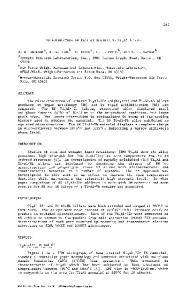Quantification of Rapidly Solidified Microstructure of Al-Fe Droplets Using Correlation Length Analysis
- PDF / 736,802 Bytes
- 8 Pages / 593.972 x 792 pts Page_size
- 40 Downloads / 334 Views
TRODUCTION
THE performance of metals is well known to be a function of the spacing and distribution of primary and secondary phases formed during solidification. This can be the case even after thermomechanical processing, which is often used in some processes such as thin-slab casting. In spite of its importance to the structureperformance-processing triangle, the notion of spacing in solidified metal samples is often an ambiguous one, typically measured through techniques based on visual inspection. Unlike special cases of well-controlled experiments (e.g., directional solidification experiments on organic alloys), which are designed to yield well-defined steady-state primary dendritic branches and tip radii, cast metals exhibit highly irregular, almost stochastic structure. Analysis of such samples requires a fundamentally different approach than the one used traditionally, an approach defined using principles of stochastic data analysis and correlation. This article presents a new quantitative approach to characterize solute segregation in rapidly solidified metal alloy powders. It applies the two-point concentration-concentration analysis to solute segregation maps, which can be obtained by a number of metallographic analyses. This approach yields an unambiguous statistical description of the primary phase distribution through the depth of the powder. It is applied, in this work, to analysis of new X-ray tomography data of rapidly solidified Al-Fe liquid droplets obtained by the impulse atomization process developed by one of the authors (HH).[1–5] This work is used both to give insight P. KUCHNIO, Research Assistant, A. TETERVAK, Postdoctoral Fellow, and N. PROVATAS, Professor, are with the Department of Materials Science and Engineering, McMaster University, Hamilton, ON, Canada L8S 4K1. Contact e-mail: [email protected] C. WATT, Graduate Student, and H. HENEIN, Professor, are with the Department of Chemical and Materials Engineering, University of Alberta, Edmonton, AB, Canada T6G 2G6. Manuscript submitted May 9, 2008. Article published online October 30, 2008 196—VOLUME 40A, JANUARY 2009
into the solidification process in these alloy powders and to illustrate application of the new correlation length analysis technique. It should be noted that the correlation length analysis technique can easily be applied to the characterization of most metal micrographs, whether obtained by X-ray data or light microscope images. While X-ray tomography was used in this article, the method is easily applicable to many sectioning methods, whether destructive or nondestructive. Correlation length analysis can also be applied to most materials with an underlying stochastic structure, not just metals. Such comparison is vital for making unambiguous quantitative comparison between different experimental or theoretical conditions and their effects on the structure-performance relation.
II.
IMPULSE ATOMIZATION TECHNIQUE
A schematic of the impulse atomization technique is shown in Figure 1. Included in this figure are the impulse genera
Data Loading...











